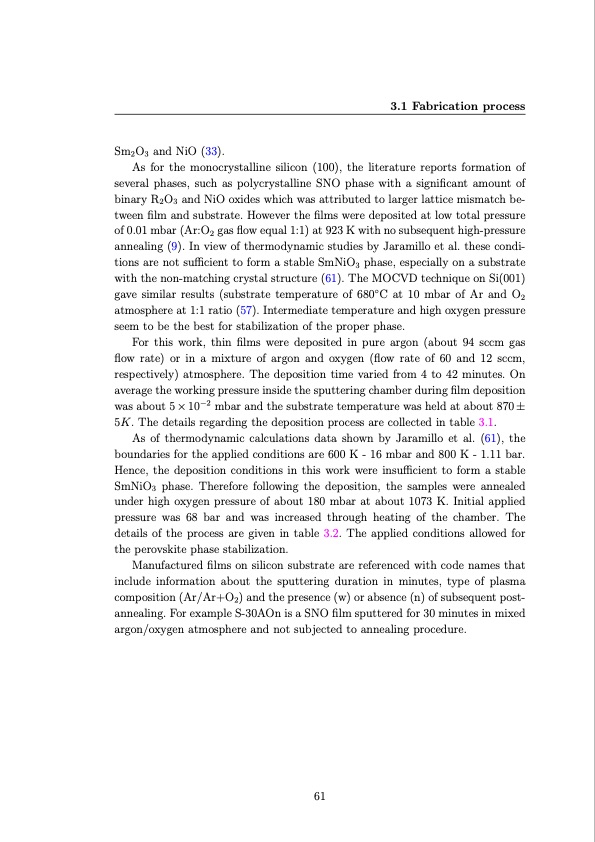
PDF Publication Title:
Text from PDF Page: 082
3.1 Fabrication process Sm2O3 and NiO (33). As for the monocrystalline silicon (100), the literature reports formation of several phases, such as polycrystalline SNO phase with a significant amount of binary R2O3 and NiO oxides which was attributed to larger lattice mismatch be- tween film and substrate. However the films were deposited at low total pressure of 0.01 mbar (Ar:O2 gas flow equal 1:1) at 923 K with no subsequent high-pressure annealing (9). In view of thermodynamic studies by Jaramillo et al. these condi- tions are not sufficient to form a stable SmNiO3 phase, especially on a substrate with the non-matching crystal structure (61). The MOCVD technique on Si(001) gave similar results (substrate temperature of 680◦C at 10 mbar of Ar and O2 atmosphere at 1:1 ratio (57). Intermediate temperature and high oxygen pressure seem to be the best for stabilization of the proper phase. For this work, thin films were deposited in pure argon (about 94 sccm gas flow rate) or in a mixture of argon and oxygen (flow rate of 60 and 12 sccm, respectively) atmosphere. The deposition time varied from 4 to 42 minutes. On average the working pressure inside the sputtering chamber during film deposition was about 5 × 10−2 mbar and the substrate temperature was held at about 870 ± 5K. The details regarding the deposition process are collected in table 3.1. As of thermodynamic calculations data shown by Jaramillo et al. (61), the boundaries for the applied conditions are 600 K - 16 mbar and 800 K - 1.11 bar. Hence, the deposition conditions in this work were insufficient to form a stable SmNiO3 phase. Therefore following the deposition, the samples were annealed under high oxygen pressure of about 180 mbar at about 1073 K. Initial applied pressure was 68 bar and was increased through heating of the chamber. The details of the process are given in table 3.2. The applied conditions allowed for the perovskite phase stabilization. Manufactured films on silicon substrate are referenced with code names that include information about the sputtering duration in minutes, type of plasma composition (Ar/Ar+O2) and the presence (w) or absence (n) of subsequent post- annealing. For example S-30AOn is a SNO film sputtered for 30 minutes in mixed argon/oxygen atmosphere and not subjected to annealing procedure. 61PDF Image | Investigation of metal-insulator transition in magnetron sputtered samarium nickelate thin films

PDF Search Title:
Investigation of metal-insulator transition in magnetron sputtered samarium nickelate thin filmsOriginal File Name Searched:
Bilewska_Investigation_of_metal_insulator_transition_in_magnetron_sputtered_samarium.pdfDIY PDF Search: Google It | Yahoo | Bing
Sulfur Deposition on Carbon Nanofibers using Supercritical CO2 Sulfur Deposition on Carbon Nanofibers using Supercritical CO2. Gamma sulfur also known as mother of pearl sulfur and nacreous sulfur... More Info
CO2 Organic Rankine Cycle Experimenter Platform The supercritical CO2 phase change system is both a heat pump and organic rankine cycle which can be used for those purposes and as a supercritical extractor for advanced subcritical and supercritical extraction technology. Uses include producing nanoparticles, precious metal CO2 extraction, lithium battery recycling, and other applications... More Info
| CONTACT TEL: 608-238-6001 Email: greg@infinityturbine.com | RSS | AMP |